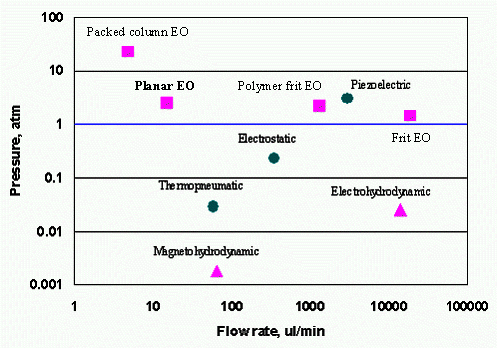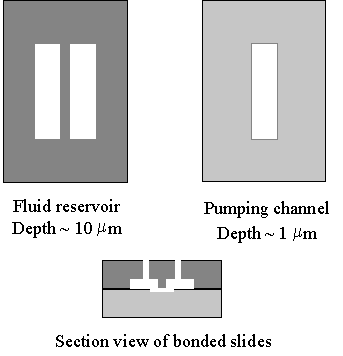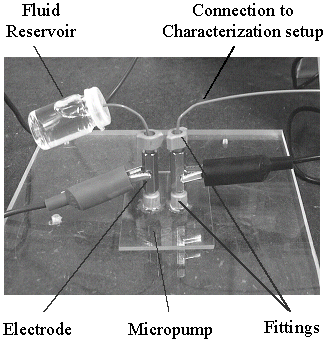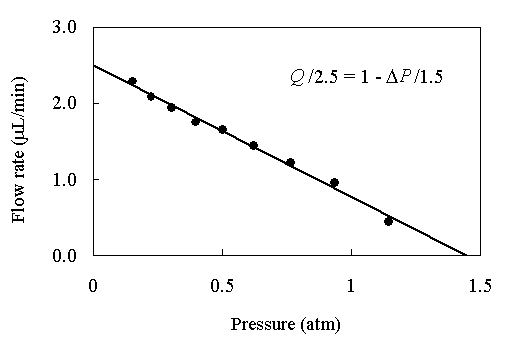Development of a Planar Electroosmotic Micropump
Motivation
A variety of micropumps have been fabricated using microfabrication techniques (Figure 1). These micropumps can be classified into two groups, mechanical and non-mechanical (without moving parts) [1]. Mechanical micropumps, such as electrostatically driven reciprocating pumps and thermopneumatically driven peristaltic pumps, consist of moving parts which are serious concern for long-term reliability. On the other hand, non-mechanical micropumps, such as electrohydrodynamic micropumps and magnetohydrodynamic micropumps, can not pump DI water (ionic conductivity range: 10-5 S/m ~ 10-2 S/m) due to their fundamental working principles. This drawback confines their applications to medical and biological applications.
A newer type of non-mechanical pump is a so-called electroosmotic (EO) pump, which uses electroosmotic flow in a porous media to generate pressures in excess of 10 and even 100 atm [2, 3]. The pressure capacity of EO pumps far exceeds the capacity of the other reported micropumps, which have a limit of 1 atm. This pump design has the advantage of being compatible with aqueous solutions as working fluid. A disadvantage of such pumps is the complexity of integrating porous media (e.g., packed silica particle beds) into microdevices. The present effort aims at fabricating a planar structure EO pump using standard microfabrication techniques such as microlithography and wet etching [4, 5].
Project Description
A simple analytical model has been developed to characterize the flow rate, pressure capacity and thermodynamic efficiency of a planar EO micropump. The dependence of flow rate and pressure capacity leads to the design of a wide, short and extremely shallow (40 mm x 1 mm x 1 mm) EO micropump, which is fabricated on Soda-lime glass substrates using standard micromachining techniques (Figure 2). Because of its relatively low ionic conductivity, DI water (10-3 S/m) is chosen as working fluid to maintain a moderate thermodynamic efficiency. The pressure vs. flow rate relationship is obtained from the testing of the pump (Figure 3).
Planar electroosmotic micropump is a non-mechanical micropump that can be fabricated using standard MEMS technology. It has demonstrated high pressure capacity (> 1 atm) using DI water as working fluid.
References
Motivation
A variety of micropumps have been fabricated using microfabrication techniques (Figure 1). These micropumps can be classified into two groups, mechanical and non-mechanical (without moving parts) [1]. Mechanical micropumps, such as electrostatically driven reciprocating pumps and thermopneumatically driven peristaltic pumps, consist of moving parts which are serious concern for long-term reliability. On the other hand, non-mechanical micropumps, such as electrohydrodynamic micropumps and magnetohydrodynamic micropumps, can not pump DI water (ionic conductivity range: 10-5 S/m ~ 10-2 S/m) due to their fundamental working principles. This drawback confines their applications to medical and biological applications.

Figure 1. Review of micropump technologies. Green represents mechanical micropumps, and pink non-mechanical One atm is the pressure performance limit of most reported micropumps.
A newer type of non-mechanical pump is a so-called electroosmotic (EO) pump, which uses electroosmotic flow in a porous media to generate pressures in excess of 10 and even 100 atm [2, 3]. The pressure capacity of EO pumps far exceeds the capacity of the other reported micropumps, which have a limit of 1 atm. This pump design has the advantage of being compatible with aqueous solutions as working fluid. A disadvantage of such pumps is the complexity of integrating porous media (e.g., packed silica particle beds) into microdevices. The present effort aims at fabricating a planar structure EO pump using standard microfabrication techniques such as microlithography and wet etching [4, 5].
Project Description
A simple analytical model has been developed to characterize the flow rate, pressure capacity and thermodynamic efficiency of a planar EO micropump. The dependence of flow rate and pressure capacity leads to the design of a wide, short and extremely shallow (40 mm x 1 mm x 1 mm) EO micropump, which is fabricated on Soda-lime glass substrates using standard micromachining techniques (Figure 2). Because of its relatively low ionic conductivity, DI water (10-3 S/m) is chosen as working fluid to maintain a moderate thermodynamic efficiency. The pressure vs. flow rate relationship is obtained from the testing of the pump (Figure 3).


Figure 2. Microfabrication and packaging.

Figure 3. Pressure ~ flow rate relationship from testing of pump Applied voltage is 3 kV, current is 7 mA Extrapolated pressure capacity is 1.5 atm, and flow rate is 2.5 ml/min
Planar electroosmotic micropump is a non-mechanical micropump that can be fabricated using standard MEMS technology. It has demonstrated high pressure capacity (> 1 atm) using DI water as working fluid.
References
- 1.) Shoji, S., and Esashi, M., “Microflow Devices and Systems”, Journal of Micromechanics and Microengineering, Vol. 4, 157-171, 1994.
- 2.) Paul, P.H., Arnold, D.W., and Rakestraw, D.J., “Electrokinetic Generation of High Pressures using Porous Microstructures”, m-TAS 98, Banff, Canada.
- 3.) C. H. Chen, J. G. Santiago, 2002, “A planar electroosmotic micropump”, Journal of Microelectromechanical Systems, vol. 11, no. 6, pp.672-683, 2002
